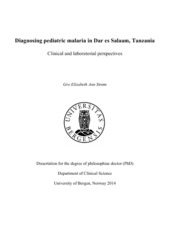| dc.contributor.author | Strøm, Gro Elizabeth Ann | en_US |
| dc.date.accessioned | 2014-05-14T13:37:46Z | |
| dc.date.available | 2014-05-14T13:37:46Z | |
| dc.date.issued | 2014-05-20 | eng |
| dc.identifier.isbn | 978-82-308-2905-9 | en_US |
| dc.identifier.uri | https://hdl.handle.net/1956/7929 | |
| dc.description.abstract | Malaria is an extensive global health issue with high morbidity and mortality. Diagnostics of malaria are challenging. Clinically malaria is indistinguishable from various other infectious diseases. Microscopy of blood smears has generally been considered the gold standard for malaria diagnostics. Rapid diagnostic tests (RDTs) and PCR are being used increasingly and may prove to be superior alternatives to microscopy, which has many limitations. However, microscopy will likely never be entirely replaced by any other method, as it is ideal for species identification, quantifying parasitemia and following response to treatment. In this study routine and research malaria microscopy, PCR and RDTs for malaria diagnostics were compared. PCR detected the most cases. Positive RDT was associated with symptoms of severe malaria. Routine malaria microscopy performed poorly and was only confirmed in 43- 53% of cases depending on choice of reference method. A strong association was found between anemia and thrombocytopenia and positive malaria results. In addition, palmar pallor and evaluation of severity of palmar pallor corresponded well with hemoglobin level. No asymptomatic malaria was found among 108 young children recruited at a health clinic in Dar es Salaam when tested with RDT and PCR of DNA extracted from dried blood spots on filter paper (DBS). Several DNA extraction methods from DBS were tested on a dilution series of a standardized Plasmodium positive sample and most performed similarly. However, the method using Chelex-100® and soaking of DBS punches in saponin overnight proved to be the method with the lowest limit of detection without missing any dilutions. This is also a method that has been used in many other studies. A TE-buffer based method performed much poorer than expected based on a previous study. PCR done on DBS detected only approximately 54% of cases positive by whole blood PCR. This was much lower than in previous studies. All cases positive on PCR of DNA extracted from DBS were also positive by RDT and by Plasmodium falciparum species-specific PCR. This confirms that it is likely that PCR of DBS detected the cases with highest parasitemia. The results of these studies support the use of RDTs for routine diagnostics where this is possible and when it is unnecessary to follow the effect of treatment or consider recrudescence, as routine microscopy performed poorly. Further studies are recommended to study asymptomatic malaria in a broader age group and a larger study population. Also, more studies comparing PCR of DNA extracted from DBS and whole blood should be done to assess whether the results of this study are representative. DBS have become popular to use in research settings in rural areas and where transport is difficult and should be evaluated to determine whether they truly perform as poorly as this study showed. Using Chelex-100® along with soaking in saponin overnight appears to be a good method for extracting DNA from DBS. | en_US |
| dc.language.iso | eng | eng |
| dc.publisher | The University of Bergen | eng |
| dc.relation.haspart | Paper I: Strom GE, Haanshuus CG, Fataki M, Langeland N, Blomberg B: Challenges in diagnosing paediatric malaria in Dar es Salaam, Tanzania. Malar J 2013, 12:228. The article is available at: <a href="http://hdl.handle.net/1956/7881" target="blank">http://hdl.handle.net/1956/7881</a> | en_US |
| dc.relation.haspart | Paper II: Strom GE, Tellevik M, Fataki M, Langeland N, Blomberg B: No asymptomatic malaria parasitaemia found among 108 young children at one health facility in Dar es Salaam, Tanzania. Malar J 2013, 12:417. The article is available at: <a href="http://hdl.handle.net/1956/7927" target="blank">http://hdl.handle.net/1956/7927</a> | en_US |
| dc.relation.haspart | Paper III: Strom GE, Tellevik MG, Hanevik K, Langeland N, Blomberg B: Comparing four methods for extracting DNA from dried blood on filter paper for PCR targeting mitochondrial Plasmodium genome. The article is not available in BORA. | en_US |
| dc.relation.haspart | Paper IV: Strom GE, Moyo S, Fataki M, Langeland N, Blomberg B. PCR targeting Plasmodium mitochondrial genome of DNA extracted from dried blood on filter paper compared to whole blood. The article is available at: <a href="http://hdl.handle.net/1956/7928" target="blank">http://hdl.handle.net/1956/7928</a> | en_US |
| dc.title | Diagnosing pediatric malaria in Dar es Salaam, Tanzania. Clinical and laboratorial perspectives | en_US |
| dc.type | Doctoral thesis | |
| dc.rights.holder | Copyright the author. All rights reserved | |
